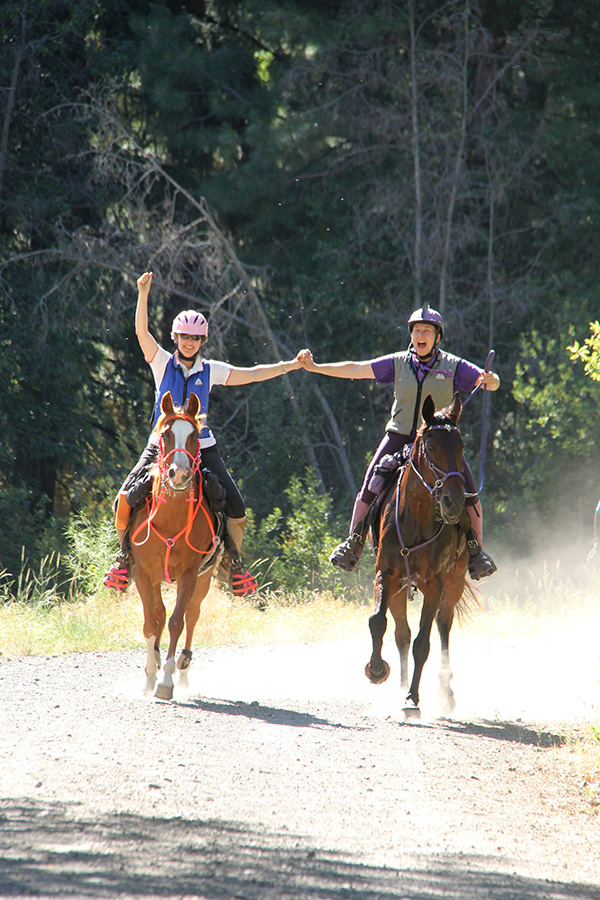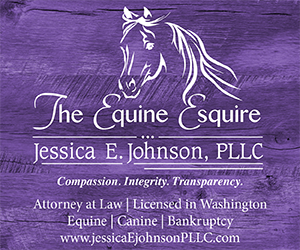The Equestrian’s Guide to Hip Replacement Surgery
by Aarene Storms

The list of reasons that I ride is familiar to readers of this magazine. I know I’m not the only one who writes the year’s social calendar based on the regional ride schedule. Riders of all ages face physical setbacks, but as we age, the obstacles start to snowball. As 20-somethings, we think nothing of riding through the pain of a smashed toe or bruised ribs. Later in life, it can be harder to enjoy riding while enduring pain accumulated from decades of horse-induced dents and dings.
Not riding is not an option for me. However, two years ago, when arthritic pain in my left hip grew unbearable, I faced a tough choice: give up riding, or submit to surgery. I’d lived with pain for a long time. I was diagnosed with arthritic changes in both hips when I was 20 years old. Almost 30 years later, walking became difficult, standing was difficult, sitting was difficult, driving was difficult, and riding was excruciating. I was terrified of hospitals, dubious about doctors, and especially skeptical about surgeons. I would do anything to keep riding, I told people. Anything, that is, except submit to surgery.
I made a list of alternatives:
- Painkillers and anti-inflammation medications. There’s a reason they talk about better living through chemistry, right?
- Injections. That stuff is awesome magic…but it doesn’t last forever.
- Physical therapy. I figured that becoming a dedicated gym rat might save me—and maybe improve the way I look in my breeches at the same time.
I wouldn’t stop riding, but it hurt and the long distance endurance events I love were no longer possible because of the pain. I found myself reaching deeper and deeper into the bottle of painkillers, even for short rides. Rock, meet hard place. So, I did research; I asked questions; I got recommendations. I found a surgeon who not only didn’t try to dissuade me from riding post-surgery—he expected me to ride my horse when I was healed up again. I also wrote a list of things that might go wrong during surgery (but probably wouldn’t).
- Zombies might take over the hospital.
- Aliens might abduct my horse from her pasture.
- The anesthesiologist might plant a post-hypnotic suggestion in my brain to make me afraid of horse spit.
It was such a pathetic list I signed up for a total hip replacement. And, to calm my fears, I made a list to mentally rehearse in the days before signing into the hospital:
- The surgery will be so boring and routine the doctor will mispronounce my name the following day.
- My family and friends will meet me in the recovery room, and somebody will stay with me in the hospital until I am released to go home.
- The hospital staff won’t try to make me eat Jello—not the regular kind and not the super-poisonous kind made with fake sugar chemicals.
- My recovery will be swift, my pain will be controlled and then outgrown, and my brain will be so super-stimulated by the meds that I will finish edits on my newest book before I have to go back to work.
- My horse will miss me (or at least remember that I’m the one who brings the cookies).
- I will be back in the saddle after a sane period of recovery, and I will be released to do whatever damn-fool thing enters my head after the 6-month mark.

The results of the whole experience? Here’s the last, and most important, list:
- The surgery was boring and routine with only a few setbacks (and no zombies).
- I was back in the saddle, on the trails, in less than a month!
- I rode my first 30-mile endurance event two months after surgery
- I returned to routinely riding longer events – 50 miles and more – within four months
- Riding doesn’t hurt any more.
Here are a few questions I get asked about the experience and my answers:
Question: You are much too young for a hip replacement! This was caused by a fall from a horse, wasn’t it? Fess up! Actually, I was born with hip dysplasia, and my poorly-designed joints held up much longer than any of the doctors expected.
Question: Did this surgery wipe out your savings account? Nope. I have excellent health insurance, and my total out-of-pocket was under $500.
Question: How much did it hurt? Before the surgery, pain made me consider giving up riding. After the surgery, not nearly so much. And, I don’t need painkillers anymore.
Question: So much for riding, huh? You have to be careful of that new hip for the rest of your life, and that means no more endurance rides. According to the surgeon, my hip is now fixed and no normal (or even extreme) athletic endeavor is out-of-bounds after 6 months of routine recovery. (He did recommend that I avoid falling off the horse for at least six months).
Question: Plastic, or titanium? Both! Ceramic and plastic for the socket and a titanium ball and stem that looks like a teeny tiny trailer hitch.
Question: My cousin’s sister’s auntie’s brother-in-law in Wyoming takes this herbal fish oil vitamin Z supplement made from shark and organic free-range sloth glands and it cures his arthritis. Why didn’t you do that instead of surgery? Before submitting to surgery, I tried chiropractics, massage, acupuncture, OTC pain meds, prescription pain meds, herbal teas, a non-inflammatory diet, cortisone injections, physical therapy, and I forget what else. Some stuff helped a bit. But, as the surgeon said when he had the raggedy sawed-off bone in his hand, there is no supplement known to humankind that would’ve relieved the pain from that crunched-up joint.
Question: What’s next? Probably another hip replacement…followed by many, many years of riding. Because not riding is not an option.
Aarene Storms returned to horses as an adult after wasting her teen years becoming educated and employed. In 1999 she rode her first long-distance event and has been active in the endurance community ever since. The author of Endurance 101,Aarene has also written numerous articles for Endurance News and other equestrian publications. Visit her at haikufarm.blogspot.com.
Published in September 2015 Issue

The Northwest Horse Source is an independently owned and operated print and online magazine for horse owners and enthusiasts of all breeds and disciplines in the Pacific Northwest. Our contemporary editorial columns are predominantly written by experts in the region, covering the care, training, keeping and enjoyment of horses, with an eye to the specific concerns in our region.





